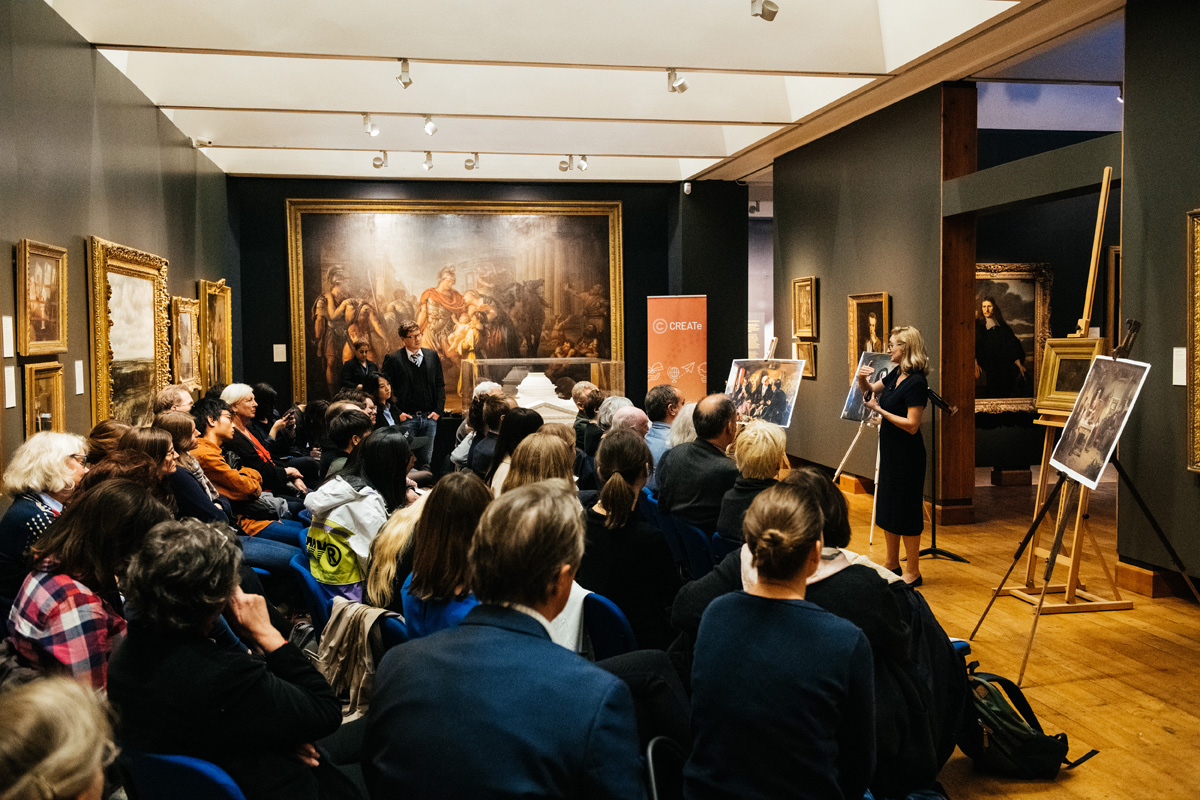In this blog, CREATe PhD candidate Jiarong Zhang reflects on two copyright history events, held on the first day of the CREATe Symposium: a roundtable discussion chaired by Dr Marta Iljadica (Lecturer in Law, CREATe) and evening lecture delivered by Dr Elena Cooper (Leverhulme Early Career Fellow, CREATe).

Dr Elena Cooper presenting ‘Whistler, Faed and Painting Copyright in the Nineteenth Century’
Photograph by Lukas Powroziewicz
On the first day of the Symposium, the focus was on copyright history. At the round-table discussion named Art, News and Markets: Copyright History and its Contemporary Echoes, chaired by CREATe’s Dr Marta Iljadica, law and non-law researchers gathered to discuss how historical perspectives connected research into the legal regulation of art, news, and markets in the nineteenth century as well as their current influences.. Until recently, copyright history has focussed, in the main, on the protection of literature and books. The first two speakers, discussed how their recent work providing an in-depth exploration of areas beyond literature – art and news – exposed new perspectives on copyright history. The first speaker, CREATe’s Dr Elena Cooper, author of Art and Modern Copyright: The Contested Image, presented an introduction and reflection on the distinct copyright issues raised by the protection of artistic works, relating to authorship, art collectors, sitters and the public interest. The discussion of copyright in the nineteenth century, and how these debates, such as those over the economic benefits and material control of artistic works continue to influence modern copyright law. Then, Will Slauter, Université Paris Diderot and author of Who Owns the News? A History of Copyright commented on how news and journalism were seen as the subject of the copyright system in the nineteenth century; the journalistic controversy stemmed not only from the close connection between news and facts, but also from the conflict between the desire of journal publishers to protect their investments or ownership of news and the need for the free flow of information. A humanities perspective on these themes was provided by Dr Anat Rosenberg, University of Cambridge and author of the book Liberalizing Contracts: Nineteenth Century Promises Through Literature, Law and History, who discussed the categories of ‘news’ and ‘advertising’ from the perspective of the history of advertising in Britain, including the authority of advertisement, differences between advertisement and science. The second part of the roundtable explored common themes between two new research projects at Glasgow concerning the criminal law, funded by Leverhulme Trust, being conducted by Dr Elena Cooper and Lindsay Farmer, Professor of criminal law at the University of Glasgow and author of the book Making the Modern Criminal Law: Criminalization and Civil Order. Lindsay Farmer explained the research questions that lie at the heart of his new Leverhulme funded project about criminal law and the regulation of markets; in the nineteenth century the regulation of the market was seen as lying beyond the proper scope of the criminal law. . Dr Cooper related these assumptions to complexities surrounding the history of the criminalisation of categories we today know as ‘intellectual property’, drawing on research about the Merchandise Marks Act 1862 and the regulation of artists signatures in the nineteenth century, for her own Leverhulme funded project on history of the criminalisation of intellectual property infringement. The concept of the ‘market’ and the relevance of ‘political economy’ to legal thinking were then connected to the history of news and advertising by Will Slauter and Anat Roseberg.
 British Literary and Artistic Copyright Association (BLACA). To celebrate the fact that the talk was the first BLACA event in Scotland in recent years, Dr Cooper connected her research into the history of artistic copyright to two paintings with links to Scotland: Brown and Gold: Portrait of Lady Eden by James McNeil Whistler (1834-1903) and Home and the Homeless by Thomas Faed (1826-1900). The original painting Portrait of Lady Eden forms part of the collection of the Hunterian Art Gallery and was brought out of the store and displayed in the Gallery for the lecture. Dr Cooper spoke on the subject of visual arts and copyright, illustrating two perspectives on copyright history by reference to the two paintings. Dr Cooper’s talk expanded on what she had said at the copyright history roundtable and analysed the differences between visual arts and books, and how visual arts, such as photographs and paintings, evolved to be subject matters of copyright. Dr Cooper’s lecture and book provide a distinct and creative perspective on copyright itself, its history, as well as modern copyright law. A resource featuring a recording of Dr Cooper’s lecture will be released shortly on the CREATe website.
British Literary and Artistic Copyright Association (BLACA). To celebrate the fact that the talk was the first BLACA event in Scotland in recent years, Dr Cooper connected her research into the history of artistic copyright to two paintings with links to Scotland: Brown and Gold: Portrait of Lady Eden by James McNeil Whistler (1834-1903) and Home and the Homeless by Thomas Faed (1826-1900). The original painting Portrait of Lady Eden forms part of the collection of the Hunterian Art Gallery and was brought out of the store and displayed in the Gallery for the lecture. Dr Cooper spoke on the subject of visual arts and copyright, illustrating two perspectives on copyright history by reference to the two paintings. Dr Cooper’s talk expanded on what she had said at the copyright history roundtable and analysed the differences between visual arts and books, and how visual arts, such as photographs and paintings, evolved to be subject matters of copyright. Dr Cooper’s lecture and book provide a distinct and creative perspective on copyright itself, its history, as well as modern copyright law. A resource featuring a recording of Dr Cooper’s lecture will be released shortly on the CREATe website.


